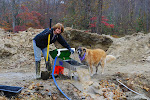Due to extensive flooding our small plane was diverted to an alternate air strip changing our original fifteen minute jeep ride to over two hours before reaching our next camp. We decided to head directly to the resort after a brief sun downer and would arrive quite late for dinner. Darkness fell and even the millions of unfamiliar stars shining so brightly in the southern sky could not illuminate the land around us. We continued on , crossing poorly constructed, half submerged log bridges and bullied our way through the thick muddy expanses on either side of the water crossings. It was slow going as we cautiously worked our way through the thick bush on narrow rutted roads traveled more by animals than vehicles.
After a call came from another ranger reporting activity at the site of a downed cape buffalo we abandoned our original plan and took a detour to check out the action. It was so tight we needed to lean to the middle of the jeep to keep from being badly scratched by the thorny acacia bushes scraping all around us. We could not see the dead buffalo, but, we knew we were close and followed our noses. We were down wind and the odor of a fifteen hundred pound cape buffalo dead for five days rotting in the bush was stomach turning. We just couldn't escape this horrible, horrible stench. After hit or miss exploring around the clumps of bushes we came upon the site and were greeted by two male spotted hyenas, larger and heavier than I imagined, standing tall and broad protecting the carcass. We were so engrossed watching the two of them taking turns eating and patrolling the area we failed at first to notice the leopard laying a short distance from the kill waiting patiently for a chance to sneak in and grab a piece of meat. A leopard is no match for a pair of hyenas and it had to be content to grab what it could. We were about forty feet from the kill and watched spellbound feeling very fortunate to have such an experience.
Time was passing and we knew we needed to move on. We would arrive much later than expected and we took one last look and prepared to depart. Unfortunately in the darkness the ranger miscalculated and jammed a downed tree under our jeep. We were stuck. We were stuck at night with two huge hyenas and a hungry leopard forty feet away and no amount of horse power or four wheel drive could move us. We were "dead in our tracks", words I never wanted to hear while on Safari! While our ranger was thinking about Plan B, the other ranger was still close by, heard our tires spinning and returned to help. He parked between our jeep and the kill, close enough so Julie, Bett and I could quickly and quietly climb aboard then repositioned his jeep even closer to the kill in order to provide more space for our guide to jack up the vehicle and drag the tree trunks out of the way.
We were all watching. We needed to keep track of the three animals especially the leopard and constantly scanned the grasses for any sign of movement. Being on the ground is much more dangerous than being in the jeep and we had three men on the ground! We now had a level of apprehension and concern layered over the level of excitement and awe. I admit I was nervous. Adrenaline was criss-crossing haphazardly through my body and my mind was playing the "what if" game. What if more hyenas appear? What if the pride of lions that probably took down this beast returns to claim the prize? Could there be a food frenzy free for all and we are stuck in the middle with three men on the ground?
We were finally freed and the three of us crawled back into our jeep to continue to the road on a more direct path through the tall grass. We traveled less than one hundred yards and we saw them. We didn't stop. We didn't even slow down. We were tired, stressed, cold and hungry and had enough adventure for one day. But, there they were, hiding in the grass facing the location of the carcass, at least twelve lions just waiting and watching.
Most of the pictures did not turn out. The red glow is from the filter placed over the spot light to keep the animals calm and to protect their eyes. We all shut off the flash settings on our cameras because we didn't want to draw attention to ourselves. The hyenas moved constantly and are reddish blurs on all of the pictures.





This shows how close we were to the action!

The rangers needed to jack up all four wheels before the jeep was freed.

A few of the lions in the pride watching us.
































